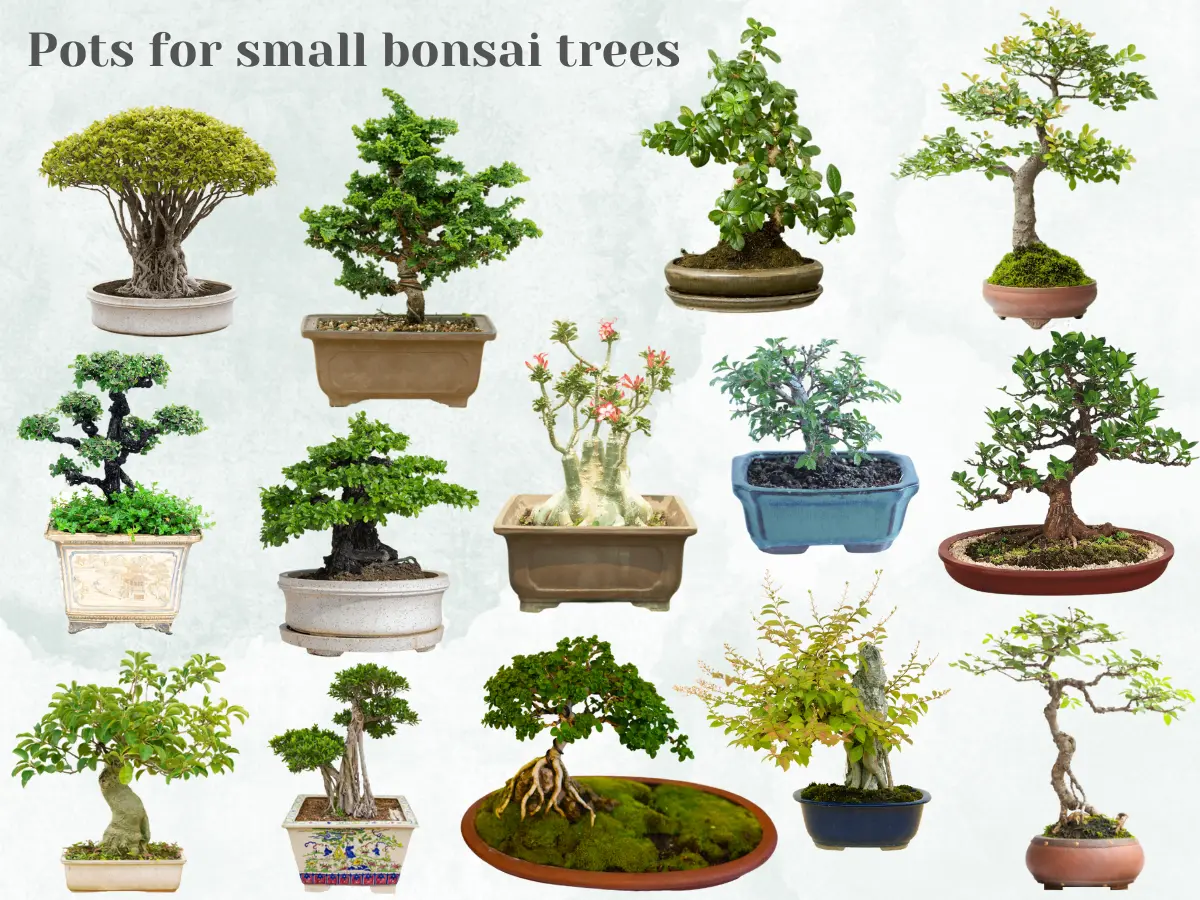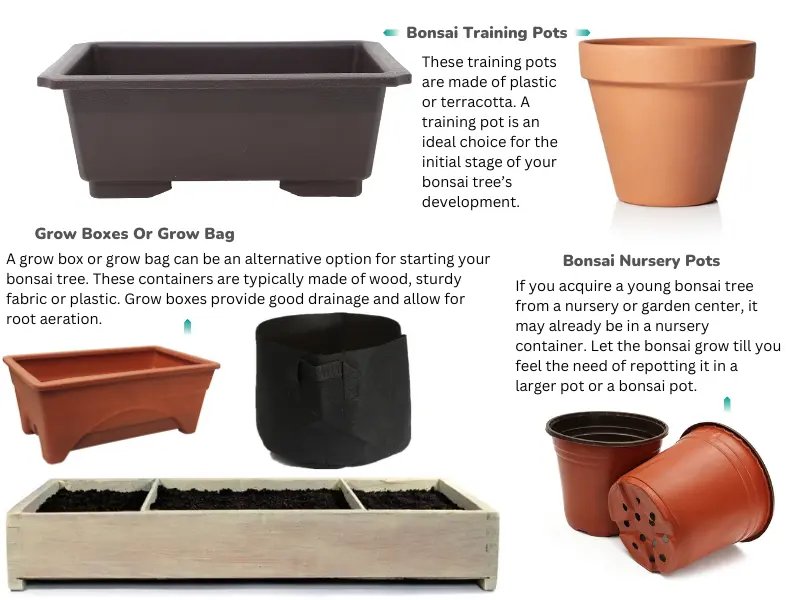Choosing the right pot for your bonsai tree is an important decision, as it can not only affect the appearance of your bonsai but also its overall health.
Deciding which bonsai pot is best for your bonsai depends on many factors such as:
- Size: The pot should be proportionate to the size of your bonsai tree. A tiny pot will not only stunt the tree’s growth but also increase the amount of care and maintenance your tree requires. For example, increased need for watering as the soil will dry up quickly. A tiny pot will also be unstable for your bonsai. Similarly, a too large bonsai pot will lead to an unwanted increase in the size of your bonsai and an unbalanced visual appearance. Continue reading Bonsai pot size for more details.
- Material: Bonsai pots are typically made from ceramic, clay, or plastic. Ceramic and clay pots are porous and allow for good drainage and aeration, but they can be heavy and breakable. Plastic pots are lightweight and durable, but lack the porosity. Continue reading Bonsai pot material for more details.
- Shape: Bonsai pots come in a variety of shapes, including oval, round, square, and rectangular. The shape of the pot should complement the shape and style of the bonsai tree.
- Color: The color of the pot should enhance the appearance of the bonsai tree. Neutral colors like brown or black are often used to keep the focus on the tree itself, while brightly colored pots can add a pop of color and visual interest. Continue reading Bonsai pot color for more details.
- Style of the bonsai tree: Bonsai style also influences which bonsai pot is chosen for the tree. Continue reading types of bonsai styles. Also, check out bonsai style chart if you need a handy chart for your reference.
- Tree species: Last but not least, the choice of bonsai pot is also influenced by the type of bonsai tree. For example: Conifers are generally planted on pots with rough and angular surface. On the other hand, deciduous bonsai trees are displayed on curved and smooth bonsai pots.
The following chart illustrates different types and sizes of bonsai pots. The chat also offers a few recommendations for bonsai trees that are suitable for a variety of pot sizes. Download bonsai pot size chart (PNG image version) or download the PDF format Bonsai pot size chart PDF.

What is the best pot shape for bonsai?
The best pot shape for a bonsai tree depends on various factors, including the bonsai tree species, the desired style, and personal preferences. While there is no single “best” pot shape, there are several common pot shapes that are often used in the art of bonsai.
Following chart shows some of the common bonsai pot shapes and common design aspects such as feet, edge design and decorations.

- Rectangular: Rectangular pots are popular for formal upright and informal upright bonsai styles. They offer a clean and modern aesthetic, providing a balanced presentation of the tree’s trunk, branches, and foliage. Rectangular pots are versatile and can be used for a wide range of tree sizes.
- Oval: Oval pots are another commonly used shape in bonsai. They are well-suited for a variety of tree styles and sizes. The gentle curves of an oval pot can enhance the natural flow and movement of the tree, creating an aesthetically pleasing composition.
- Round: Round pots are often associated with informal or cascading bonsai styles. They can provide a sense of harmony and balance, particularly for trees with softer or more rounded foliage. Round pots are also suitable for accent plants or smaller bonsai trees.
- Square: Square pots offer a more angular and contemporary look. They can work well for trees with a formal or upright style, emphasizing the straight lines and structured appearance of the trunk and branches.
- Other shapes: Apart from the common shapes, there are also bonsai pots available in hexagon, octagon or abstract shapes. The use of these types of bonsai pots depends on the artistic outlook of the bonsai grower. These shapes are not commonly used.
- Feet and edge of a bonsai pot: In addition to the geometric shape, the design of the feet and edges of a bonsai pot also contribute significantly to the overall shape of the pot.
Conifers are generally planted in pots with rough, angular surfaces. Conversely, deciduous bonsai trees are displayed in curved and smooth bonsai pots.
The best pot shape for a bonsai tree is one that complements the tree’s style and characteristics, enhancing its overall aesthetics. It’s wise to consider the tree’s size, shape, and the desired visual impact when selecting a pot shape. Experimentation and personal preference also play a role, as there is room for creativity and individual interpretation in the art of bonsai.
What pots are best for small bonsai trees?

When it comes to small bonsai trees, there are a few pot options that are well-suited to their needs. However, these are not special bonsai pots. These are regular bonsai pots, just small in size. Here are some pots that are considered best for small bonsai trees:
- Shallow Pots: Small bonsai trees often benefit from shallow pots. These pots have a relatively low depth compared to their width, allowing for better proportionality and stability for the smaller root systems of young or small bonsai trees. Shallow pots also provide good water drainage and aeration to prevent waterlogging.
- Training Pots: Training pots are temporary containers used during the initial stages of a bonsai tree’s development. They are usually made of plastic or malleable materials that allow for easy root pruning and training. Training pots provide flexibility and convenience for frequent root work, which is essential for shaping and establishing the desired structure of small bonsai trees.
- Ceramic or Clay Pots: Ceramic or clay pots can be great choices for small bonsai trees. They offer stability, insulation, and durability. Ceramic or clay pots provide a more aesthetic and natural appearance, enhancing the overall visual appeal of the bonsai. They also help regulate moisture and provide good airflow to the roots. Using a bright glazed pot is generally not advised as the size of the tree is small and bright glaze will overpower the plant. However, you can use glazed pots with subtle glaze.
- Small Decorative Pots: Small decorative pots can add charm and style to small bonsai trees. These pots often come in various shapes, colors, and designs, allowing for personalization and enhancing the artistic presentation of the tree. They should still provide adequate space for root growth and have good drainage capabilities.
When selecting a pot for a small bonsai tree, it’s essential to consider the tree’s root system, growth stage, and the desired aesthetic. The pot should be proportionate to the tree’s size, provide sufficient space for root development, and have proper drainage to ensure the tree’s health and well-being.
What pot should I put my bonsai tree in first?

When selecting the first pot for your bonsai tree, it’s important to consider its current stage of development (eg: a young sapling, training phase or established tree) and the specific needs of the tree. Here are a few recommendations for the initial pot for your bonsai:
- Training Pot: A training pot is an ideal choice for the initial stage of your bonsai tree’s development. These pots are typically made of plastic or other malleable materials. However, training pots made of terracotta are also available. They allow for easy root pruning, training, and shaping of the tree. Training pots provide flexibility and convenience during the early stages when frequent adjustments and root work are required. Read more materials used to make bonsai pots.
- Nursery Container: If you acquire a young bonsai tree from a nursery or garden center, it may already be in a nursery container. These containers are often plastic pots designed for growing and nurturing young plants. They provide ample space for root development and are suitable for the initial stages of training and growth. Furthermore, in most nurseries, the plants are already fertilized for the season. Hence, you do not even have to worry about fertilizing the plant in the first season.
- Grow Box: A grow box or grow bag can be an alternative option for starting your bonsai tree. These containers are typically made of wood, sturdy fabric or plastic and are designed for plant cultivation. Grow boxes provide good drainage and allow for root aeration. They are an affordable and practical choice, especially for bonsai enthusiasts who want to start with seedlings or small nursery plants. Large grow boxes also give you the option of planting more than one tree. If you have the tools available, you can even make your own custom grow box.
- Bonsai pot: If you are acquiring an established bonsai tree, you can plant the tree in bonsai pot.
Remember, the first pot you choose should be large enough to accommodate the initial root system while providing adequate space for future growth. It’s important to monitor the tree’s root development and plan for eventual repotting into a more suitable bonsai pot as the tree matures and progresses in its training process. Continue reading How to repot a bonsai tree.
Consider the size and species of the bonsai tree, as well as the training goals you have in mind. Consulting with experienced bonsai enthusiasts or professionals can also provide valuable guidance and help you make an informed decision on the appropriate first pot for your bonsai tree.

